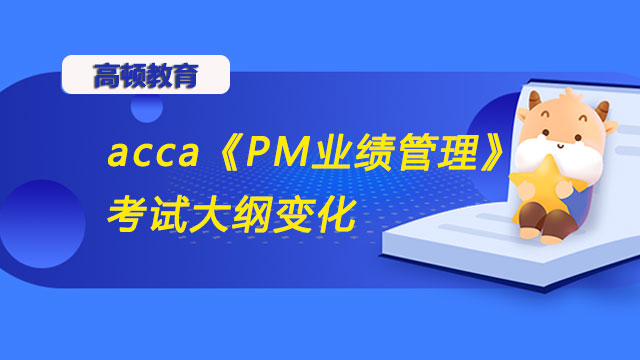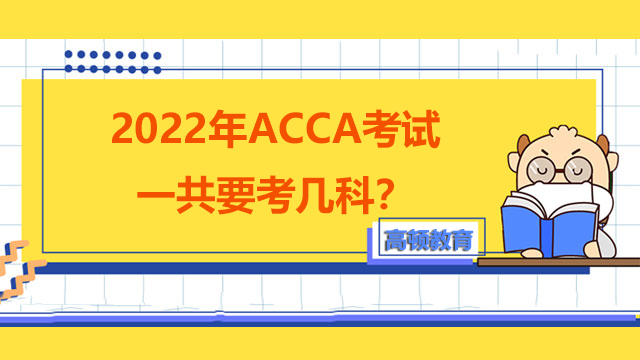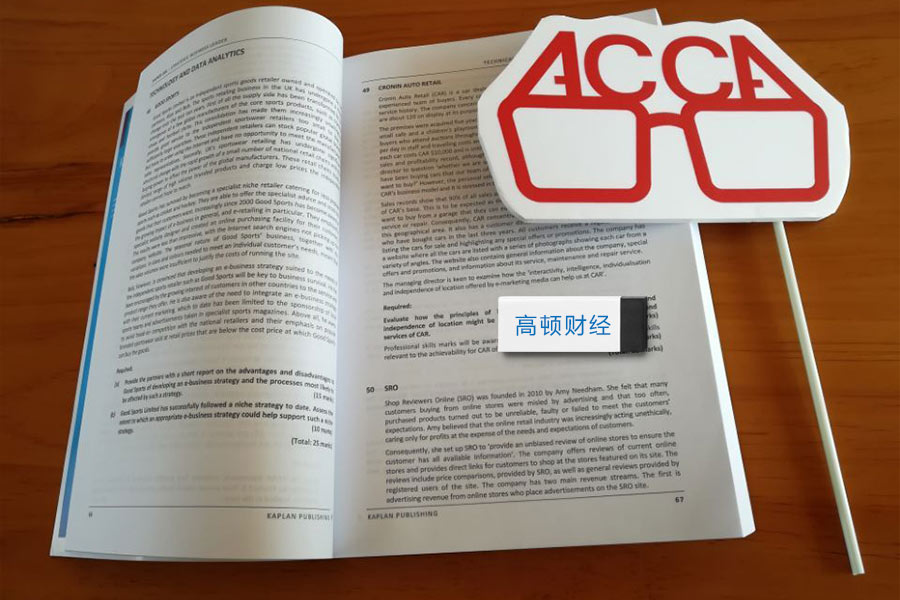2015年ACCA P6 高级税务考试大纲
来源:
高顿网校
2015-03-25
? ACCA 2015 All rights reserved.
1
Advanced Taxation (UK)
(P6)
Exams in the financial
year 1 April 2015 to 31
March 2016
This syllabus and study guide is designed to help
with planning study and to provide detailed
information on what could be assessed in
any examination session.
THE STRUCTURE OF THE SYLLABUS AND
STUDY GUIDE
Relational diagram of paper with other papers
This diagram shows direct and indirect links
between this paper and other papers preceding or
following it. Some papers are directly underpinned
by other papers such as Advanced Performance
Management by Performance Management. These
links are shown as solid line arrows. Other papers
only have indirect relationships with each other
such as links existing between the accounting and
auditing papers. The links between these are shown
as dotted line arrows. This diagram indicates where
you are expected to have underpinning knowledge
and where it would be useful to review previous
learning before undertaking study.
Overall aim of the syllabus
This explains briefly the overall objective of the
paper and indicates in the broadest sense the
capabilities to be developed within the paper.
Main capabilities
This paper’s aim is broken down into several main
capabilities which divide the syllabus and study
guide into discrete sections.
Relational diagram of the main capabilities
This diagram illustrates the flows and links between
the main capabilities (sections) of the syllabus and
should be used as an aid to planning teaching and
learning in a structured way.
Syllabus rationale
This is a narrative explaining how the syllabus is
structured and how the main capabilities are linked.
The rationale also explains in further detail what the
examination intends to assess and why.
Detailed syllabus
This shows the breakdown of the main capabilities
(sections) of the syllabus into subject areas. This is
the blueprint for the detailed study guide.
Approach to examining the syllabus
This section briefly explains the structure of the
examination and how it is assessed.
Study Guide
This is the main document that students, tuition
providers and publishers should use as the basis of
their studies, instruction and materials.
Examinations will be based on the detail of the
study guide which comprehensively identifies what
could be assessed in any examination session.
The study guide is a precise reflection and
breakdown of the syllabus. It is divided into sections
based on the main capabilities identified in the
syllabus. These sections are divided into subject
areas which relate to the sub-capabilities included
in the detailed syllabus. Subject areas are broken
down into sub-headings which describe the detailed
outcomes that could be assessed in examinations.
These outcomes are described using verbs
indicating what exams may require students to
demonstrate, and the broad intellectual level at
which these may need to be demonstrated
(*see intellectual levels below)。
INTELLECTUAL LEVELS
The syllabus is designed to progressively broaden
and deepen the knowledge, skills and professional
values demonstrated by the student on their way
through the qualification.
The specific capabilities within the detailed
syllabuses and study guides are assessed at one of
three intellectual or cognitive levels:
LevelⅠ: Knowledge and comprehension
LevelⅡ: Application and analysis
? ACCA 2015 All rights reserved.
2
LevelⅢ: Synthesis and evaluation
Very broadly, these intellectual levels relate to the
three cognitive levels at which the Knowledge
module, the Skills module and the Professional level
are assessed.
Each subject area in the detailed study guide
included in this document is given a 1, 2, or
3 superscript, denoting intellectual level, marked at
the end of each relevant line. This gives an
indication of the intellectual depth at which an area
could be assessed within the examination. However,
while level 1 broadly equates with the Knowledge
module, level 2 equates to the Skills module and
level 3 to the Professional level, some lower level
skills can continue to be assessed as the student
progresses through each module and level. This
reflects that at each stage of study there will be a
requirement to broaden, as well as deepen
capabilities. It is also possible that occasionally
some higher level capabilities may be assessed at
lower levels.
LEARNING HOURS AND EDUCATION
RECOGNITION
The ACCA qualification does not prescribe or
recommend any particular number of learning hours
for examinations because study and learning
patterns and styles vary greatly between people and
organisations. This also recognises the wide
diversity of personal, professional and educational
circumstances in which ACCA students find
themselves.
As a member of the International Federation of
Accountants, ACCA seeks to enhance the education
recognition of its qualification on both national and
international education frameworks, and with
educational authorities and partners globally. In
doing so, ACCA aims to ensure that its qualifications
are recognized and valued by governments,
regulatory authorities and employers across all
sectors. To this end, ACCA qualifications are
currently recognized on the education frameworks in
several countries. Please refer to your national
education framework regulator for further
information.
Each syllabus contains between 23 and 35 main
subject area headings depending on the nature of
the subject and how these areas have been broken
down.
GUIDE TO EXAM STRUCTURE
The structure of examinations varies within and
between modules and levels.
The Fundamentals level examinations contain
100% compulsory questions to encourage
candidates to study across the breadth of each
syllabus.
The Knowledge module is assessed by equivalent
two-hour paper based and computer based
examinations.
The Skills module examinations F5-F9 are all paper
based three-hour papers containing a mixture of
objective and longer type questions. The Corporate
and Business Law (F4) paper is a two-hour
computer based objective test examination which is
also available as a paper based version from the
December 2014 examination session.
The Professional level papers are all three-hour
paper based examinations, all containing two
sections. Section A is compulsory, but there will be
some choice offered in Section B.
For all three hour examination papers, ACCA has
introduced 15 minutes reading and planning time.
This additional time is allowed at the beginning of
each three-hour examination to allow candidates to
read the questions and to begin planning their
answers before they start writing in their answer
books. This time should be used to ensure that all
the information and exam requirements are properly
read and understood.
During reading and planning time candidates may
only annotate their question paper. They may not
write anything in their answer booklets until told to
do so by the invigilator.
The Essentials module papers all have a Section A
containing a major case study question with all
requirements totalling 50 marks relating to this
case. Section B gives students a choice of two from
three 25 mark questions.
Section A of both the P4 and P5 Options papers
contain one 50 mark compulsory question, and
? ACCA 2015 All rights reserved.
3
Section B will offer a choice of two from three
questions each worth 25 marks each.
Section A of each of the P6 and P7 Options papers
contains 60 compulsory marks from two questions;
question 1 attracting 35 marks, and question 2
attracting 25 marks. Section B of both these
Options papers will offer a choice of two from three
questions, with each question attracting 20 marks.
All Professional level exams contain four
professional marks.
The pass mark for all ACCA Qualification
examination papers is 50%.
GUIDE TO EXAMINATION ASSESSMENT
ACCA reserves the right to examine anything
contained within the study guide at any examination
session. This includes knowledge, techniques,
principles, theories, and concepts as specified.
For the tax papers, ACCA will publish examinable
documents, or tax rates and allowances tables, once
a year to indicate exactly what legislation could
potentially be assessed within identified
examination sessions. These should be read in
conjunction with the information below.
For UK tax papers, examinations falling within the
financial year 1 April to 31 March will examine the
Finance Act which was passed in the previous July.
I.e. Exams falling in the period 1 April 2015 to 31
March 2016 will examine the Finance Act 2014.
For SGP tax papers, examinations falling within the
year 1 April to 31 March will be based on
legislation passed before the previous 30
September. I.e. examinations falling in the year 1
April 2015 to 31 March 2016 will be based on
legislation passed by 30 September 2014.
For MYS tax papers, examinations falling within the
year 1 October to 30 September will be based on
legislation passed before the previous 31 March.
I.e. examinations falling in the year 1 October 2014
to 30 September 2015 will be based on legislation
passed before the previous 31 March 2014.
For CYP tax papers, June and December
examinations will be based on regulation or
legislation published in the Official Gazette of the
Republic of Cyprus (“the Gazette”) on or before 30
September. I.e. June and December 2015 papers
will be based on regulation or legislation published
in the Official Gazette of the Republic of Cyprus
(“the Gazette”) on or before 30 September 2014.
For CZE tax papers, December and June
examinations will be based on legislation passed
before the previous 31 May. I.e. December 2014
and June 15 papers will be based on legislation in
force at 31 May 2014.
For VNM tax papers, June and December
examinations will be based on legislation passed
before the previous 31 December. I.e. June and
December 2015 papers will be based on legislation
passed by 31 December 2014.
Tax papers for the following variants:
BWA, CHN, HUN, HKG, IRL, LSO, MWI, MLA,
POL, PKN, ROM, RUS, ZAF, ZWE.
The June and December examinations will be based
on legislation passed before the previous 30
September. I.e. June and December 2015 papers
will be based on legislation passed by 30
September 2014.
? ACCA 2015 All rights reserved.
4
Syllabus
AIM
To apply relevant knowledge and skills and exercise
professional judgement in providing relevant
information and advice to individuals and
businesses on the impact of the major taxes on
financial decisions and situations.
.
MAIN CAPABILITIES
On successful completion of this paper candidates
should be able to:
A Apply further knowledge and understanding
of the UK tax system through the study of more
advanced topics within the taxes studied
previously and the study of stamp taxes
B Identify and evaluate the impact of relevant
taxes on various situations and courses of
action, including the interaction of taxes
C Provide advice on minimising and/or deferring
tax liabilities by the use of standard tax
planning measures
D Communicate with clients, HM Revenue and
Customs and other professionals in an
appropriate manner.
RELATIONAL DIAGRAM OF MAIN CAPABILITIES
TX (F6)
ATX (P6)
Communication with clients, H M Revenue and Customs and
other professionals in an appropriate manner (D)
Impact of relevant taxes
on various situations and
courses of action,
including the interaction
of taxes (B)
Minimising and/or
deferring tax
liabilities by the use
of standard tax
planning measures
(C)
Understanding of the tax system through the study of more advanced topics
within the taxes studied previously and the study of stamp taxes (A)
? ACCA 2015 All rights reserved.
5
RATIONALE
The Advanced Taxation syllabus further develops
the key aspects of taxation introduced in the
compulsory Taxation syllabus within the Skills
module and extends the candidates’ knowledge of
the tax system, together with their ability to apply
that knowledge to the issues commonly encountered
by individuals and businesses, such that successful
candidates should have the ability to interpret and
analyse the information provided and communicate
the outcomes in a manner appropriate to the
intended audience.
The syllabus builds on the basic knowledge of core
taxes from the earlier taxation paper and introduces
candidates to stamp taxes. As this is an optional
paper, aimed at those requiring/desiring more than
basic tax knowledge for their future professional
lives, the syllabus also extends the knowledge of
income tax, corporation tax, capital gains tax and
inheritance tax to encompass, further overseas
aspects of taxation, the taxation of trusts and
additional exemptions and reliefs.
Computations will normally only be required in
support of explanations or advice and not in
isolation.
Candidates are not expected to concentrate on the
computational aspects of taxation. Instead this
paper seeks to develop candidates’ skills of analysis,
interpretation and communication. Candidates are
expected to be able to use established tax planning
methods and consider current issues in taxation.
DETAILED SYLLABUS:
A Knowledge and understanding of the UK tax
system through the study of more advanced
topics within the taxes studied previously and
the study of stamp taxes.
1. Income and income tax liabilities in situations
involving further overseas aspects and in
relation to trusts, and the application of
additional exemptions and reliefs.
2. Chargeable gains and capital gains tax
liabilities in situations involving further
overseas aspects and in relation to closely
related persons and trusts, and the application
of additional exemptions and reliefs.
3. Inheritance tax in situations involving further
aspects of the scope of the tax and the
calculation of the liabilities arising, the
principles of valuation and the reliefs available,
transfers of property to and from trusts,
overseas aspects and further aspects of
administration.
4. Corporation tax liabilities in situations involving
overseas and further group aspects and in
relation to special types of company, and the
application of additional exemptions and
reliefs.
5. Stamp taxes
6. Value added tax, tax administration and the
UK tax system
B The impact of relevant taxes on various
situations and courses of action, including the
interaction of taxes
1. Taxes applicable to a given situation or course
of action and their impact.
2. Alternative ways of achieving personal or
business outcomes may lead to different tax
consequences.
3. Taxation effects of the financial decisions
made by businesses (corporate and
unincorporated) and by individuals.
4. Tax advantages and/or disadvantages of
alternative courses of action.
5. Statutory obligations imposed in a given
situation, including any time limits for action
and the implications of non-compliance.
C Minimising and/or deferring tax liabilities by
the use of standard tax planning measures
1. Types of investment and other expenditure that
will result in a reduction in tax liabilities for an
individual and/or a business.
2. Legitimate tax planning measures, by which
the tax liabilities arising from a particular
situation or course of action can be mitigated.
? ACCA 2015 All rights reserved.
6
3. The appropriateness of such investment,
expenditure or measures, given a particular
taxpayer’s circumstances or stated objectives.
4. The mitigation of tax in the manner
recommended, by reference to numerical
analysis and/or reasoned argument.
5. Ethical and professional issues arising from the
giving of tax planning advice.
6. Current issues in taxation.
D Communicating with clients, HM Revenue and
Customs and other professionals
1. Communication of advice, recommendations
and information in the required format.
2. Presentation of written information, in language
appropriate to the purpose of the
communication and the intended recipient.
3. Conclusions reached with relevant supporting
computations.
4. Assumptions made or limitations in the
analysis provided, together with any
inadequacies in the information available
and/or additional information required to
provide a fuller analysis.
5. Other non-tax factors that should be
considered.
? ACCA 2015 All rights reserved.
7
APPROACH TO EXAMINING THE SYLLABUS
The paper consists of two sections:
Section A consists of two compulsory questions.
Question 1 has 35 marks, including 4 professional
marks, and question 2 has 25 marks
Section B consists of three 20-mark questions, two
of which must be answered.
Questions will be scenario based and will normally
involve consideration of more than one tax, together
with some elements of planning and the interaction
of taxes. Computations will normally only be
required in support of explanations or advice and
not in isolation.
The examination is a three hour paper, with 15
minutes additional reading and planning time.
Tax rates, allowances and information on certain
reliefs will be given in the examination paper.
? ACCA 2015 All rights reserved.
8
Study Guide
A APPLY FURTHER KNOWLEDGE AND
UNDERSTANDING OF THE UK TAX SYSTEM
THROUGH THE STUDY OF MORE ADVANCED
TOPICS WITHIN THE TAXES STUDIED
PREVIOUSLY AND THE STUDY OF STAMP
TAXES
1. Income and income tax liabilities in situations
involving further overseas aspects and in
relation to trusts, and the application of
exemptions and reliefs
a) The contents of the Paper F6 study guide for
income tax and national insurance, under
headings: [2]
? B1 The scope of income tax
? B2 Income from employment
? B3 Income from self employment
? B4 Property and investment income
? B5 The comprehensive computation of
taxable income and the income tax liability
? B6 National insurance contributions for
employed and self-employed persons
? B7 The use of exemptions and reliefs in
deferring and minimising income tax
liabilities
The following additional material is also
examinable:
b) The scope of income tax: [3]
i) Explain and apply the concepts of residence
and domicile and advise on the relevance to
income tax
ii) Advise on the availability of the remittance
basis to UK resident individuals [2]
iii) Advise on the tax position of individuals
coming to and leaving the UK
iv) Determine the income tax treatment of
overseas income
v) Understand the relevance of the OECD
model double tax treaty to given situations
vi) Calculate and advise on the double taxation
relief available to individuals
c) Income from employment: [3]
i) Advise on the tax treatment of share option
and share incentive schemes, including
employee shareholder shares
ii) Advise on the tax treatment of lump sum
receipts
iii) Advise on the overseas aspects of income
from employment, including travelling and
subsistence expenses
iv) Identify personal service companies and
advise on the tax consequences of providing
services via a personal service company
d) Income from self employment: [3]
i) Advise on a change of accounting date
ii) Advise on the relief available for trading
losses following the transfer of a business to
a company
iii) Recognise the tax treatment of overseas
travelling expenses
iv) Advise on the allocation of the annual
investment allowance between related
businesses
v) Identify the enhanced capital allowances
available in respect of expenditure on green
technologies[2]
e) Property and investment income: [3]
i) Recognise income subject to the accrued
income scheme
ii) Advise on the tax implications of jointly
held assets
iii) Income from trusts and settlements:
Understand the income tax position of trust
beneficiaries
f) The comprehensive computation of taxable
income and the income tax liability:[3]
i) Advise on the income tax position of the
income of minor children
g) The use of exemptions and reliefs in deferring
and minimising income tax liabilities:
i) Understand and apply the rules relating to
investments in the seed enterprise
investment scheme and the enterprise
investment scheme [3]
ii) Understand and apply the rules relating to
investments in venture capital trusts [3]
Excluded topics
The scope of income tax:
? Details of specific anti-avoidance
provisions, except as stated in the
study guide.
? ACCA 2015 All rights reserved.
9
Income from employment:
? Explanation of the PAYE system.
? The calculation of a car benefit where
emission figures are not available.
Income from self employment:
? The 100% first year allowance for
renovating business premises in
disadvantaged areas and flats above
shops.
? Capital allowances for agricultural
buildings, patents, scientific research
and know how.
? Enterprise zones.
? The allocation of notional profits and
losses for a partnership.
? Farmers averaging of profits.
? The averaging of profits for authors
and creative artists.
? Details of specific anti-avoidance
provisions, except as stated in the
study guide.
? Investment income of a partnership
Property and investment income:
? The deduction for expenditure by
landlords on energy-saving items
? Pre-owned assets
National insurance:
? The calculation of directors’ national
insurance on a month by month basis.
? Contracted out contributions.
? The offset of trading losses against nontrading
income and capital gains.
Income from trusts and settlements:
? The computation of income tax payable
by trustees.
? Overseas aspects.
The comprehensive computation of taxable
income and the income tax liability:
? The blind person’s allowance and the
married couple’s age allowance.
? Tax credits.
? Maintenance payments.
? Charitable donations.
? Social security benefits apart from the
State Retirement Pension.
The use of exemptions and reliefs in deferring
and minimising income tax liabilities:
? The conditions that need to be satisfied for
pension schemes to be registered by HM
Revenue and Customs.
2. Chargeable gains and capital gains tax liabilities
in situations involving further overseas aspects
and in relation to closely related persons and
trusts together with the application of additional
exemptions and reliefs
a) The contents of the Paper F6 study guide
for chargeable gains for individuals under
headings:[2]
? C1 The scope of the taxation of capital
gains
? C2 The basic principles of computing
gains and losses
? C3 Gains and losses on the disposal of
movable and immovable property
? C4 Gains and losses on the disposal of
shares and securities
? C5 The computation of capital gains
tax
? C6 The use of exemptions and reliefs in
deferring and minimising tax liabilities
arising on the disposal of capital assets
The following additional material is also
examinable:
b) The scope of the taxation of capital gains: [3]
i) Determine the tax implications of
independent taxation and transfers between
spouses
ii) Identify the concepts of residence and
domicile and determine their relevance to
capital gains tax
iii) Advise on the availability of the remittance
basis to non-UK domiciled individuals [2]
iv) Determine the UK taxation of foreign
gains, including double taxation relief
v) Conclude on the capital gains tax position
of individuals coming to and leaving the
UK
vi) Identify the occasions when a capital gain
would arise on a partner in a partnership on
the disposal of a partnership asset
c) Capital gains tax and trusts:
i) Advise on the capital gains tax implications
of transfers of property into trust. [3]
? ACCA 2015 All rights reserved.
10
ii) Advise on the capital gains tax implications
of property passing absolutely from a trust
to a beneficiary.[2]
d) The basic principles of computing gains and
losses: [3]
i) Identify connected persons for capital gains
tax purposes and advise on the tax
implications of transfers between connected
persons
ii) Advise on the impact of dates of disposal
and conditional contracts
iii) Evaluate the use of capital losses in the
year of death
e) Gains and losses on the disposal of movable
and immovable property: [3]
i) Advise on the tax implications of a part
disposal, including small part disposals of
land
ii) Determine the gain on the disposal of
leases and wasting assets
iii) Establish the tax effect of capital sums
received in respect of the loss, damage or
destruction of an asset
iv) Advise on the tax effect of making
negligible value claims
v) Determine when capital gains tax can be
paid by instalments and evaluate when this
would be advantageous to taxpayers
f) Gains and losses on the disposal of shares and
securities: [3]
i) Extend the explanation of the treatment of
rights issues to include the small part
disposal rules applicable to rights issues
ii) Define a qualifying corporate bond (QCB),
and understand what makes a corporate
bond non-qualifying. Understand the capital
gains tax implications of the disposal of
QCBs in exchange for cash or shares
iii) Apply the rules relating to reorganisations,
reconstructions and amalgamations and
advise on the most tax efficient options
available in given circumstances
iv) Establish the relief for capital losses on
shares in unquoted trading companies [3]
g) The use of exemptions and reliefs in deferring
and minimising tax liabilities arising on the
disposal of capital assets: [3]
i) Understand and apply enterprise
investment scheme reinvestment relief
ii) Understand and apply seed enterprise
investment scheme reinvestment relief
iii) Advise on the availability of entrepreneurs’
relief in relation to associated disposals
iv) Understand and apply the relief that is
available on the transfer of an
unincorporated business to a limited
company
v) Understand the capital gains tax
implications of the variation of wills
Excluded topics
The scope of the taxation of capital gains:
? Detailed knowledge of the statements
of practice on partnership capital gains.
? Deemed disposals on a change in the
profit sharing ratio (PSR) of a
partnership
Capital gains tax and trusts:
? Overseas aspects of capital gains tax
and trusts.
? The computation of capital gains tax
payable by trustees.
? Transfers of property to or from trustees
prior to 22 March 2006.
? Knowledge of situations where property
is transferred between trusts or where
the terms or nature of the trust is
altered.
? Knowledge of situations where property
within a trust with an immediate postdeath
interest passes to the spouse or
civil partner of the settlor on the death
of the life tenant.
? Knowledge of the special rules
concerning trusts for the disabled,
trusts for bereaved minors, transitional
serial interest trusts and age 18 to 25
trusts.
The basic principles of computing gains and
losses:
? Assets held at 31 March 1982.
? Relief for losses on loans made to
traders.
? ACCA 2015 All rights reserved.
11
Gains and losses on the disposal of movable
and immovable property:
? The detailed calculations for chattels
where the cost or proceeds are less
than ?6,000, other than knowledge of
the exemption where both cost and
proceeds are less than ?6,000.
? Sets of chattels in relation to the
chattels exemption.
? The grant of a lease or sub-lease out of
either a freehold, long lease or short
lease.
? Appropriations to and from trading
stock (inventory)。
Gains and losses on the disposal of shares and
securities:
? Computation of cost and indexed cost
within the s.104 TCGA 1992 share
pool
3. Inheritance tax in situations involving further
aspects of the scope of the tax and the
calculation of the liabilities arising, the
principles of valuation and the reliefs available,
transfers of property to and from trusts,
overseas aspects and further aspects of
administration
a) The contents of the Paper F6 study guide
for inheritance tax under headings:[2]
? D1 The basic principles of computing
transfers of value
? D2 The liabilities arising on the
chargeable lifetime transfers and on the
death of an individual
? D3 The use of exemptions in deferring
and minimising inheritance tax
liabilities
? D4 Payment of inheritance tax
The following additional material is also
examinable:
b) The scope of inheritance tax:
i) Explain the concepts of domicile and
deemed domicile and understand the
application of these concepts to inheritance
tax [2]
ii) Identify excluded property [2]
iii) Identify and advise on the tax implications
of the location of assets [3]
iv) Identify and advise on gifts with reservation
of benefit [3]
v) Identify and advise on the tax implications
of associated operations [2]
c) The basic principles of computing transfers of
value:
i) Advise on the principles of valuation[3]
ii) Advise on the availability of business
property relief and agricultural property
relief[3]
iii) Identify exempt transfers [2]
d) The liabilities arising on chargeable lifetime
transfers and on the death of an individual: [3]
i) Advise on the tax implications of chargeable
lifetime transfers
ii) Advise on the tax implications of transfers
within seven years of death
iii) Advise on the tax liability arising on a death
estate
iv) Advise on the relief for the fall in value of
lifetime gifts
v) Advise on the operation of quick succession
relief
vi) Advise on the operation of double tax relief
for inheritance tax
vii) Advise on the inheritance tax effects and
advantages of the variation of wills
e) The liabilities arising in respect of transfers to
and from trusts and on property within
trusts:
i) Define a trust [2]
ii) Distinguish between different types of
trust [3]
iii) Advise on the inheritance tax implications
of transfers of property into trust [3]
iv) Advise on the inheritance tax implications
of property passing absolutely from a trust
to a beneficiary [2]
v) Identify the occasions on which
inheritance tax is payable by trustees [3]
f) The use of exemptions and reliefs in deferring
and minimising inheritance tax liabilities: [3]
i) Advise on the use of reliefs and exemptions
to minimise inheritance tax liabilities, as
mentioned in the sections above
g) The system by which inheritance tax is
administered, including the instalment option
for the payment of tax:
? ACCA 2015 All rights reserved.
12
i) Identify the occasions on which inheritance
tax may be paid by instalments.[2]
ii) Advise on the due dates, interest and
penalties for inheritance tax purposes.[3]
Excluded topics
The scope of inheritance tax:
? Pre 18 March 1986 lifetime transfers.
? Transfers of value by close companies.
The liabilities arising on chargeable lifetime
transfers and on the death of an individual:
? Double grossing up on death.
? Post mortem reliefs.
? Relief on relevant business property and
agricultural property given as exempt
legacies.
? Detailed knowledge of the double charges
legislation.
Computing transfers of value:
? Valuation of an annuity or an interest in
possession where the trust interest is
subject to an annuity.
? Woodlands relief.
? Conditional exemption for heritage property.
Inheritance tax and trusts:
? IHT aspects of discretionary trusts prior to
27 March 1974.
? Trusts created prior to 22 March 2006.
? Computation of ten year charges and exit
charges.
? The computation of inheritance tax payable
by trustees of an immediate post-death
interest trust.
? Overseas aspects of inheritance tax and
trusts.
? The conditions that had to be satisfied for a
trust to be an accumulation and
maintenance trust.
? Knowledge of situations where property is
transferred between trusts or where the
terms or nature of the trust is altered.
? Knowledge of situations where property
within a trust with an immediate post-death
interest passes to the spouse or civil partner
of the settlor on the death of the life tenant.
? Knowledge of the special rules concerning
trusts for the disabled, trusts for bereaved
minors, transitional serial interest trusts and
age 18 to 25 trusts.
4. Corporation tax liabilities in situations
involving further overseas and group aspects
and in relation to special types of company,
and the application of additional exemptions
and reliefs
a) The contents of the Paper F6 study guide, for
corporation tax, under headings:[2]
? E1 The scope of corporation tax
? E2 Taxable total profits
? E3 Chargeable gains for companies
? E4 The comprehensive computation of the
corporation tax liability
? E5 The effect of a group corporate structure
for corporation tax purposes
? E6 The use of exemptions and reliefs in
deferring and minimising corporation tax
liabilities
The following additional material is also
examinable:
b) The scope of corporation tax: [3]
i) Identify and calculate corporation tax
for companies with investment business.
ii) Close companies:
? Apply the definition of a close
company to given situations
? Conclude on the tax implications of
a company being a close company
or a close investment holding
company
iii) Identify and evaluate the significance of
accounting periods on administration or
winding up
iv) Conclude on the tax treatment of returns to
shareholders after winding up has
commenced
v) Advise on the tax implications of a
purchase by a company of its own shares
vi) Identify personal service companies and
advise on the tax consequences of services
being provided via a personal service
company
c) Taxable total profits: [3]
i) Identify qualifying research and
development expenditure, both capital and
revenue, and determine the reliefs available
by reference to the size of the individual
company/group
? ACCA 2015 All rights reserved.
13
ii) Recognise the relevance of a company
generating profits attributable to patents
iii) Identify the enhanced capital allowances
available in respect of expenditure on green
technologies, including the tax credit
available in the case of a loss making
company
iv) Determine the tax treatment of non trading
deficits on loan relationships
v) Recognise the alternative tax treatments of
intangible assets and conclude on the best
treatment for a given company
vi) Advise on the impact of the transfer
pricing and thin capitalisation rules on
companies
vii) Advise on the restriction on the use of
losses on a change in ownership of a
company
d) The comprehensive calculation of the
corporation tax liability: [3]
i) Assess the impact of the OECD model
double tax treaty on corporation tax
ii) Evaluate the meaning and implications of a
permanent establishment
iii) Identify and advise on the tax implications
of controlled foreign companies
iv) Advise on the tax position of overseas
companies trading in the UK
v) Calculate double taxation relief
e) The effect of a group structure for corporation
tax purposes: [3]
i) Advise on the allocation of the annual
investment allowance between group
or related companies
ii) Advise on the tax consequences of a
transfer of intangible assets
iii) Advise on the tax consequences of a
transfer of a trade and assets where there is
common control
iv) Understand the meaning of consortium
owned company and consortium member [2]
v) Advise on the operation of consortium
relief
vi) Determine pre-entry losses and
understand their tax treatment
vii) Determine the degrouping charge where a
company leaves a group within six years of
receiving an asset by way of a no gain/no
loss transfer
viii) Determine the effects of the anti-avoidance
provisions, where arrangements exist for a
company to leave a group
ix) Advise on the tax treatment of an overseas
branch
x) Advise on the relief for trading losses
incurred by an overseas subsidiary
f) The use of exemptions and reliefs in deferring
and minimising corporation tax liabilities: [3]
i) Advise on the availability, and the
application of disincorporation relief
ii) Determine the application of the substantial
shareholdings exemption
Excluded topics
The scope of corporation tax:
? Details of specific anti-avoidance
provisions, except as stated in the
Study Guide.
The comprehensive calculation of the
corporation tax liability:
? Corporation tax rates for companies in
the process of winding up.
? Relief for overseas tax as an expense.
? Detailed knowledge of specific double
taxation agreements.
? Migration of a UK resident company.
? Mixer companies.
? Detailed computational questions on
the carry back and carry forward of
unrelieved foreign tax.
? Quarterly accounting for income tax.
5. Stamp taxes (stamp duty, stamp duty reserve
tax, and stamp duty land tax)
a) The scope of stamp taxes: [3]
i) Identify the property in respect of which
stamp taxes are payable.
b) Identify and advise on the liabilities arising on
transfers. [3]
i) Advise on the stamp taxes payable on
transfers of shares and securities
ii) Advise on the stamp taxes payable on
transfers of land
c) The use of exemptions and reliefs in deferring
and minimising stamp taxes: [3]
? ACCA 2015 All rights reserved.
14
i) Identify transfers involving no
consideration
ii) Advise on group transactions
d) Understand and explain the systems by which
stamp taxes are administered.[2]
Excluded topics
The scope of stamp taxes:
? Leases.
The liabilities arising on transfers:
? The contingency principle.
? Residential property held by non-natural
persons.
The systems by which stamp taxes are
administered:
? Detailed rules on interest and penalties.
6. Value added tax, tax administration and the
UK tax system:
a) The contents of the Paper F6 study guide for
value added tax (VAT) under headings:
? F1 The VAT registration requirements:
? F2 The computation of VAT liabilities:
? F3 The effect of special schemes
The following additional material is also
examinable:
i) Advise on the impact of the disaggregation
of business activities for VAT purposes [3]
ii) Advise on the impact of divisional
registration [3]
iii) Advise on the VAT implications of the
supply of land and buildings in the UK
iv) Advise on the VAT implications of partial
exemption
v) Advise on the application of the capital
goods scheme
b) The contents of the Paper F6 study guide for
the UK tax system and its administration under
headings:
? A1 The overall function and purpose of
taxation in a modern economy
? A2 Principal sources of revenue law
and practice
? A3 The systems for self assessment
and the making of returns
? A4 The time limits for the submission
of information, claims and payment of
tax, including payments on account
? A5 The procedures relating to
compliance checks, appeals and
disputes
? A6 Penalties for non-compliance
No additional material at this level
Excluded topics
Value added tax:
? The determination of the tax point.
? The contents of a valid VAT invoice.
? Do it yourself builders.
? Second hand goods scheme.
? Retailers’ schemes.
? Schemes for farmers.
B THE IMPACT OF RELEVANT TAXES ON
VARIOUS SITUATIONS AND COURSES OF
ACTION, INCLUDING THE INTERACTION OF
TAXES
1. Identify and advise on the taxes applicable to a
given course of action and their impact.[3]
2. Identify and understand that the alternative
ways of achieving personal or business
outcomes may lead to different tax
consequences
a) Calculate the receipts from a transaction, net of
tax and compare the results of alternative
scenarios and advise on the most tax efficient
course of action.[3]
3. Advise how taxation can affect the financial
decisions made by businesses (corporate and
unincorporated) and by individuals
a) Understand and compare and contrast the tax
treatment of the sources of finance and
investment products available to individuals.[3]
b) Understand and explain the tax implications of
the raising of equity and loan finance.[3]
? ACCA 2015 All rights reserved.
15
c) Explain the tax differences between decisions
to lease, use hire purchase or purchase
outright.[3]
d) Understand and explain the impact of taxation
on the cash flows of a business.[3]
4 Assess the tax advantages and disadvantages
of alternative courses of action.[3]
5. Understand the statutory obligations imposed
in a given situation, including any time limits
for action and advise on the implications of
non-compliance.[3]
C MINIMISE AND/OR DEFER TAX LIABILITIES
BY THE USE OF STANDARD TAX PLANNING
MEASURES
1. Identify and advise on the types of investment
and other expenditure that will result in a
reduction in tax liabilities for an individual
and/or a business.[3]
2. Advise on legitimate tax planning measures, by
which the tax liabilities arising from a
particular situation or course of action can be
mitigated.[3]
3. Advise on the appropriateness of such
investment, expenditure or measures given a
particular taxpayer’s circumstances or stated
objectives.[3]
4. Advise on the mitigation of tax in the manner
recommended by reference to numerical
analysis and/or reasoned argument.[3]
5. Be aware of the ethical and professional issues
arising from the giving of tax planning advice.[3]
6. Be aware of and give advice on current issues
in taxation.[3]
D COMMUNICATE WITH CLIENTS, HM
REVENUE AND CUSTOMS AND OTHER
PROFESSIONALS IN AN APPROPRIATE
MANNER
1. Communicate advice, recommendations and
information in the required format:[3]
For example the use of:
? Reports
? Letters
? Memoranda
? Meeting notes
2. Present written information, in language
appropriate to the purpose of the
communication and the intended recipient.[3]
3. Communicate conclusions reached, together,
where necessary with relevant supporting
computations.[3]
4. State and explain assumptions made or
limitations in the analysis provided; together
with any inadequacies in the information
available and/or additional information required
to provide a fuller analysis.[3]
5. Identify and explain other, non-tax, factors that
should be considered.[3]
? ACCA 2015 All rights reserved.
16
SUMMARY OF CHANGES TO PAPER P6 (UK)
ACCA periodically reviews its qualification syllabuses
so that they fully meet the needs of stakeholders
such as employers, students, regulatory and advisory
bodies and learning providers.
Some of the syllabus areas have been reordered as shown in Table 1 below:
Table 1 - Reordering within P6 (UK)
Section and subject area Amendment
Reordering of syllabus area A The syllabus areas have been reordered so that syllabus area
A1 covers income tax and national insurance, A2 covers
chargeable gains, A3 covers inheritance tax, A4 covers
corporation tax, A5 covers stamp taxes and A6 covers value
added tax, tax administration and the UK tax system
National insurance National insurance has been moved to syllabus area A1
The main areas that have been added to the syllabus are shown in Table 2 below:
Table 2 - Additions to P6 (UK)
Section and subject area Amendment
A1 Income tax Employee shareholder shares added to section A1 (c) (i)
A2 Chargeable gains Seed enterprise investment scheme reinvestment relief has
been removed from excluded topics and is now included in
section A2(g)(ii)
A3 Inheritance tax – Excluded topics The computation of inheritance tax payable by trustees of an
immediate post-death interest trust added to excluded topics
The main areas that have been deleted from the syllabus are showing in Table 3 below:
Table 3 - Deletions from P6 (UK)
Section and subject area Amendment
A1 (d) – Income from self-employment Recognise the tax treatment of the investment income of a
partnership
A1 (e) – Property and investment income Assess the tax implications of pre-owned assets
A1 (g) – The use of exemptions and reliefs in
deferring and minimising income tax liabilities
Explain the conditions that need to be satisfied for pension
schemes to be registered by HM Revenue and Customs
A2 (e) – Gains and losses on the disposal of
movable and immovable property
Explain the tax effect of appropriations to and from trading
stock (inventory)
The main areas that have been amended or clarified in the syllabus are shown in Table 4 below:
Table 4 - Amendments to P6 (UK)
Section and subject area Amendment
A2 (b) (vi) – Identify the occasions when a
capital gain would arise on a partner in a
partnership
Clarified as Identify the occasions when a capital gain would
arise on a partner in a partnership on the disposal of a
partnership asset.
A2 (b) - The scope of the taxation of capital Deemed disposals on a change in the profit sharing ratio
? ACCA 2015 All rights reserved.
17
gains (PSR) of a partnership moved to excluded topics
A2 Chargeable gains – Excluded topics Amended to clarify that whilst the detailed calculations for
chattels where cost or proceeds are under ?6,000 are
excluded from the syllabus, knowledge of the exemption
where both cost and proceeds are less than ?6,000
continues to be examinable.
高顿网校温馨提示: 通过ACCA考试实属不易,首先要有执着的精神,其次是不断勤奋的学习,高顿网校为大家提供ACCA题库免费做题,希望助大家一臂之力,查看详情》
| ACCA网络课程 | 课程专业名称 | 讲师 | 试听 |
 85%的人正在学习该课程 85%的人正在学习该课程 | ACCA 全维度网课体验课程 实景课堂与独立录制 覆盖所有知识点,根据学习计划推进学习进度 | 高顿名师 |  |
 70%的人正在学习该课程 70%的人正在学习该课程 | ACCA网课全科卡(8.2折) 为零基础刚开始学习ACCA的学员特别定制 | 高顿名师 |  |
精彩推荐:
版权声明:本条内容自发布之日起,有效期为一个月。凡本网站注明“来源高顿教育”或“来源高顿网校”或“来源高顿”的所有作品,均为本网站合法拥有版权的作品,未经本网站授权,任何媒体、网站、个人不得转载、链接、转帖或以其他方式使用。
经本网站合法授权的,应在授权范围内使用,且使用时必须注明“来源高顿教育”或“来源高顿网校”或“来源高顿”,并不得对作品中出现的“高顿”字样进行删减、替换等。违反上述声明者,本网站将依法追究其法律责任。
本网站的部分资料转载自互联网,均尽力标明作者和出处。本网站转载的目的在于传递更多信息,并不意味着赞同其观点或证实其描述,本网站不对其真实性负责。
如您认为本网站刊载作品涉及版权等问题,请与本网站联系(邮箱fawu@gaodun.com,电话:021-31587497),本网站核实确认后会尽快予以处理。
点一下领资料
【整理版】ACCA各科目历年真题
真题高频考点,刷题全靠这份资料
下载合集
acca全科学习思维导图
梳理核心考点,一图看懂全部章节
下载合集
2023年acca考纲解析
覆盖科目重难点,备考按照计划走
下载合集
acca备考 热门问题解答
- acca考试怎么搭配科目?
-
建议优先选择相关联的科目进行搭配报考,这样可以提高备考效率,减轻备考压力,1、F1-F4:为随时机考科目,难度较低,这里可以自行随意选择考试顺序。2、F5-F9:如果你的工作的和财务会计或者审计有关、或者你比较擅长财务和审计的话,推荐先考F7和F8。你可以选择一起考ACCA考试科目F7和F8或者先考F7(8)再考F8(7),这就要取决你一次想考几门。3、P阶段:选修科目中,建议企业首选AFM!第二部分科目进行选择,如果AA和SBR掌握学生更好,可以通过选择AAA,如果SBL掌握的好,可以自己选择APM。
- acca一共几门几年考完?
-
acca一共有15门考试科目,其中有必修科目和选修科目,考生需要考完13门科目才能拿下证书。
- acca一年考几次?
-
acca一年有4次考试,分别是3月、6月、9月和12月,分季机考科目是采取的这类四个考季的模式,而随时机考则是没有这方面的时间规定限制,可以随报随考。
- acca的含金量如何?
-
ACCA证书的含金量是比较高的,从就业、能力提升、全球认可等角度来说,都是比较有优势的证书,其含金量主要表现在以下几个方面:1、国际化,认可度高;2、岗位多,就业前景好;3、缺口大,人才激励。
严选名师 全流程服务
其他人还搜了
热门推荐
-
长春ACCA培训课程,高顿ACCA推荐吗? 2023-06-19
-
【考试重点】acca2023年9月SBL变化详解,速进了解! 2023-06-19
-
acca《PM业绩管理》考试大纲变化,2023年9月起变动情况一览! 2023-04-26
-
2023年6月acca考试哪些科目考纲有变化?赶快来看! 2023-04-25
-
ACCA2023年考试重点介绍,新手看过来! 2023-03-29
-
9月acca考试考纲变了吗?这些科目变动你要了解! 2023-03-10
-
acca考纲每次变化大吗?2023年9月起变动0%-12%! 2023-03-10
-
ACCA科目名称英文一览 2022-05-23
-
ACCA都考什么内容? 2022-05-20
-
ACCA课程内容介绍 2022-05-12
-
2022年ACCA考试一共要考几科? 2022-05-11
-
ACCA的考试内容都有什么? 2022-05-10
-
ACCA官网操作 | 如何鉴别自己是FIA还是ACCA&考试报名退考流程 2021-06-30
-
2020年最新ACCA考试大纲哪里找? 2020-03-04
-
2014年12月ACCA考试改动方向及难度变化,资阳考生必看! 2019-01-04
-
2014年12月ACCA考试改动方向及难度变化,资阳考生必看! 2019-01-04
-
2018年ACCA考试新旧考纲变化详解 2019-01-02
-
12月ACCA考试前瞻:2017年9月ACCA F7考试分析 2017-11-21
-
ACCA考试F8考试大纲变化解析 2017-04-19
-
ACCA考试F7考纲变化分析 2017-01-04
-
acca福建厦门考点i831在哪里 2016-12-19
-
拉萨有没有比较好的ACCA培训机构? 2016-06-29
-
石嘴山有没有比较好的ACCA培训机构? 2016-06-29
-
嘉峪关有没有比较好的ACCA培训机构? 2016-06-29
-
吐鲁番有没有比较好的ACCA培训机构? 2016-06-29
-
武夷山有没有比较好的ACCA培训机构? 2016-06-29
-
保山有没有比较好的ACCA培训机构? 2016-06-22
-
果洛有没有比较好的ACCA培训机构? 2016-06-22
-
临夏有没有比较好的ACCA培训机构? 2016-06-22
-
喀什有没有比较好的ACCA培训机构? 2016-06-22
 更多服务
更多服务





























